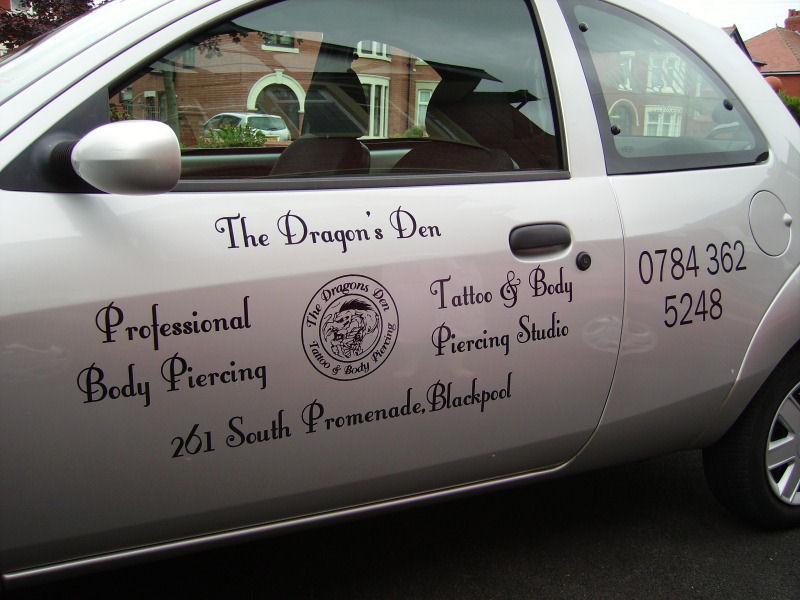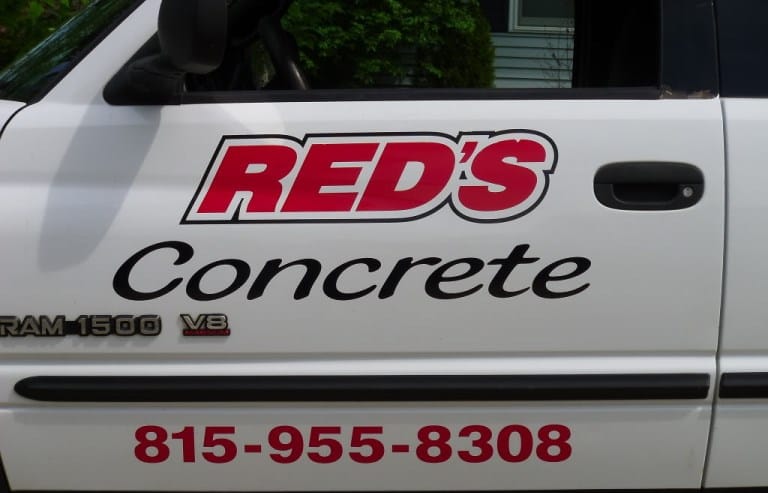Vinyl vehicle lettering has become increasingly popular in recent years, thanks to its cost-effective nature and professional appearance. It involves designing and cutting out vinyl letters and graphics to adhere to vehicles, creating a personalized and eye-catching look.
It can be used for a variety of purposes, such as advertising a business or brand, personalizing a vehicle, or displaying contact information. It is a versatile and durable option that can withstand extreme temperatures and weather conditions, making it an ideal choice for both personal and business use.
What is Self-adhesive Vinyl Vehicle Lettering?
Self-adhesive vinyl vehicle lettering is a type of removable and durable signage designed specifically for use on cars, trucks, vans, and other vehicles. Manufactured using high-quality vinyl material, these custom-made letters and graphics come with a strong adhesive backing that allows for easy application directly onto the exterior surface of a vehicle. The ability to withstand harsh weather conditions, fading, and peeling makes it an ideal choice for businesses and individuals seeking to advertise their brand or simply personalize their mode of transportation.
Why Vehicle Lettering?
It has become a popular choice for individuals and businesses alike due to its ability to effectively communicate a message while making a striking visual impact. When applied to a car, truck, van, or any other vehicle, custom lettering transforms that mode of transportation into a mobile billboard, reaching a wider audience. As a cost-effective form of advertisement, vehicle lettering offers a potentially high return on investment, making it an attractive option for businesses of all sizes.
It also provides an opportunity for personal expression, as vehicle owners can customize their cars with unique designs or messages. Vehicle lettering is built to withstand harsh weather conditions, ensuring that the message remains vibrant and intact for an extended period. Overall, vehicle lettering proves to be an invaluable tool for capturing attention, promoting brands, and showcasing individuality on the road.
Vinyl Vehicle Lettering Features

- Versatile Design: It can be custom designed to match your desired colors, fonts, and overall style.
- Durable: Made with high-quality, long-lasting materials that can withstand various weather conditions, including rain, heat, and UV rays.
- Cost-Effective Advertising: It effectively turns your vehicle into a mobile billboard, promoting your brand wherever you go.
- Easy Application & Removal: The self-adhesive nature of vinyl lettering allows for easy application and removal without damaging the vehicle’s paintwork.
- Wide Range of Uses: Suitable for businesses of all sizes and types, as well as individuals who want to customize their vehicles for personal use.
- High Visibility: It ensures your message or brand is highly visible to pedestrians and other motorists on the road.
- Resistant to Fading: The use of UV inks in vinyl lettering ensures the colors will not fade over time, maintaining their bold, vibrant look.
- Long-lasting: It typically lasts several years, making it a worthwhile long-term investment.
Vinyl Types for Vehicle Lettering
When it comes to vehicle lettering, there are several types of vinyl that you can choose from, each with its unique properties and benefits:
- Cast Vinyl is a premium, highly durable option perfect for both long-term and intricate applications due to its thinness and flexibility.
- Calendered vinyl, while less expensive than cast vinyl, is thicker and less conformable, making it suitable for flat surfaces and shorter-term needs.
- High performance (HP) vinyl is a middle ground between cast and calendered vinyl, offering moderate durability and flexibility.
- Reflective vinyl and metallic vinyl are more specialized options, with reflective vinyl providing visibility in low-light conditions and metallic vinyl offering a shiny, chrome-like finish for a striking look.
Your choice of vinyl type largely depends on the application, desired longevity, budget, and aesthetic preference for your vehicle lettering.
How to Install Vinyl Vehicle Lettering?
- Clean the Application Surface: Thoroughly remove dirt, grime, or wax from the area of the vehicle where the lettering will be applied. A mixture of mild dish detergent and warm water generally suffices to clean the surface.
- Prepare Your Design: Layout your vinyl lettering design on a flat surface. Measure and cut pieces as needed.
- Measure and Mark the Application Area: Using a tape measure and masking tape, mark the precise location on your vehicle where you want to apply the lettering.
- Peel Off the Backing Paper: Carefully peel the backing paper away from the vinyl lettering, ensuring the lettering stays attached to the transfer tape.
- Apply the Lettering to the Vehicle: Align the edge of the decal with the marked area on your vehicle. Gently lay the decal onto the surface, using a squeegee or a credit card to press it down firmly and smoothly. Start from the center and work your way out to prevent air bubbles.
- Remove the Transfer Tape: Slowly peel away the transfer tape, starting from one corner and moving diagonally across the decal. Ensure the vinyl letters stick to the vehicle’s surface as you peel off the tape.
- Smooth Out Any Bubbles: If any bubbles appear under the vinyl, use a squeegee or a credit card to push them out towards the edge of the decal.
- Maintain: After your vinyl letters are applied, avoid washing your vehicle for at least 24 hours to allow the adhesive to bond properly.
Remember, detailed instructions and care guidelines should be included with your vinyl lettering kit. If any discrepancies occur, always follow the instructions provided by the manufacturer.
What Kind of Surfaces Does Vinyl Vehicle Lettering Work?
 It can be applied to a wide variety of surfaces on cars, trucks, vans, and other vehicles, including glass, metal, and some plastics used in vehicle manufacturing. While vinyl lettering adheres best to smooth, flat surfaces, it can also be applied on slightly curved surfaces due to its flexibility, particularly when using high-quality cast vinyl.
It can be applied to a wide variety of surfaces on cars, trucks, vans, and other vehicles, including glass, metal, and some plastics used in vehicle manufacturing. While vinyl lettering adheres best to smooth, flat surfaces, it can also be applied on slightly curved surfaces due to its flexibility, particularly when using high-quality cast vinyl.
However, it is not advisable to apply vinyl lettering on textured or porous surfaces, as these can prevent proper adhesion and may result in the vinyl peeling or bubbling.
Prior to applying vinyl lettering, it is crucial to thoroughly clean and dry the desired surface to ensure the longevity and appearance of the lettering. Simply put, if the surface of your vehicle is reasonably smooth and made of compatible materials, vinyl vehicle lettering should work effectively for your customization or advertising needs.
Will the Vinyl Vehicle Lettering Damage Your Paint Job?
As a general rule, it should not damage your vehicle’s paint job. The adhesives used in the manufacturing of vinyl letters are designed to adhere strongly to the vehicle surface without causing harm to the underlying paint. In fact, once applied, the vinyl can act as a protective layer against UV exposure, reducing the risk of paint fading over time. However, care should be taken when removing the vinyl lettering. Done too hastily or without proper technique, removal can potentially cause some minor damage or leave adhesive residue.
It is highly recommended to follow a specific set of instructions, often involving the use of heat and careful peeling, when removing vinyl lettering to ensure the undamaged condition of your vehicle’s paint. Always ensure that any pre-existing paint job is entirely cured before application of the vinyl to avoid complications during removal.
What is the Difference Between Vinyl Letters and Decals?
 Vinyl letters and decals serve a similar purpose – they’re both used to apply graphics, text, or logos onto a surface, often for advertising or personal expression. However, they differ significantly in their construction and application.
Vinyl letters and decals serve a similar purpose – they’re both used to apply graphics, text, or logos onto a surface, often for advertising or personal expression. However, they differ significantly in their construction and application.
Vinyl letters are individually cut from a vinyl material, with each character separate from the rest. This makes them an exceptional choice for adding text to a vehicle, window, or other surfaces, especially when you desire a painted-on look without any background material visible around the letters.
On the other hand, decals are designs or text printed onto a sheet of vinyl. They usually come as one piece and are often used for complex or colored designs that may not be feasible with individual cut vinyl letters. Decals may leave a clear or colored outline around the design, depending on how they are printed and cut.
Can You Wash and Wax Over Vinyl Vehicle Lettering?
Vinyl vehicle lettering, once applied and set, is designed to withstand standard vehicle cleaning and maintenance practices, including washing and waxing. You’re free to wash your vehicle as you normally would, even with the vinyl letters affixed. Just ensure to use a non-abrasive cloth or sponge and avoid high pressure washing directly on the lettering to prevent inadvertent peeling or lifting of the edges.
As for waxing, you can wax over the vinyl letters, but it’s important to use a wax that is safe for vinyl surfaces. Some types of wax, especially those with high petroleum distillates, can potentially degrade the vinyl over time. Always ensure to use gentle cleaning and waxing methods to prolong the life and maintain the appearance of your vinyl vehicle lettering.
How to Care for Your Vinyl Vehicle Lettering?
 Proper care can significantly extend its lifespan and keep the appearance looking sharp and professional. Begin by allowing the vinyl adhesive to bond completely, typically waiting at least 24 hours after application before washing your vehicle. When cleaning, use a soft, non-abrasive cloth or sponge to gently wash the area around the lettering, using mild soap and water, and avoid high pressure washers or spot-free rinses containing harsh chemicals.
Proper care can significantly extend its lifespan and keep the appearance looking sharp and professional. Begin by allowing the vinyl adhesive to bond completely, typically waiting at least 24 hours after application before washing your vehicle. When cleaning, use a soft, non-abrasive cloth or sponge to gently wash the area around the lettering, using mild soap and water, and avoid high pressure washers or spot-free rinses containing harsh chemicals.
Wax over vinyl lettering occasionally, opting for a vinyl-safe wax to ensure the longevity of the vinyl material and avoid damage caused by petroleum-based waxes. It is crucial to park your vehicle in a shaded area or indoors whenever possible, as this can help reduce exposure to UV radiation and extreme heat, which can cause fading and deterioration over time. By taking these care measures into consideration, you can significantly contribute to the long-lasting and attractive appearance of your vinyl vehicle lettering.
How Do You Remove Vinyl Vehicle Lettering?
- Apply Heat: Start by using a heat gun or a hair dryer to warm the vinyl lettering. This helps to loosen the adhesive, making removal easier. Be careful not to overheat the area as it can potentially damage the paint underneath.
- Peel Off the Vinyl: Start peeling off the lettering carefully at one corner. Try to peel back rather than lift up the letters as this prevents the potential stretching or tearing of the vinyl.
- Clean Remaining Adhesive: After all the vinyl letters have been removed, there may be adhesive residue left on the vehicle. Use a clean cloth with rubbing alcohol or an adhesive remover designed for automotive paint to remove this residue.
- Wash the Area: Once the adhesive has been fully removed, wash the area with soap and water to get rid of any remaining residue and gently dry it.
- Polish the Surface: For a flawless finish, consider applying a light coat of automotive polish to blend the newly exposed paint with the surrounding area. This should help to restore any minor variations in the paint’s shine.
Remember to work slowly and carefully throughout this process to avoid causing any damage to your vehicle’s paint job.
How Long Does Vinyl Vehicle Lettering Last?
The lifespan of vinyl vehicle lettering largely depends on several factors including the quality of the vinyl material used, the application process, and how well it’s maintained. Generally, high-quality outdoor vinyl used for vehicle lettering can last anywhere between 5 to 9 years. Premium cast vinyl tends to last longer, thanks to its durability and ability to withstand various weather conditions including sun exposure, rain, and cold temperatures.
However, this longevity can be shortened if the vehicle is regularly exposed to harsh environmental conditions, abrasive cleaners, improper washing techniques, or constant high-pressure washing. Regular cleaning with gentle, vinyl-safe products and parking the vehicle in a garage or shaded area can help extend the lifespan of vinyl vehicle lettering. It’s also worth noting that colors may fade over time, especially reds and other bright colors, due to prolonged UV exposure.
Conclusion
Vinyl vehicle lettering is a popular and effective method of personalizing or advertising on various types of vehicles, with the added benefit of being both removable and durable. These graphics can be applied to a range of smooth, non-porous surfaces and offer a professional appearance without causing damage to your vehicle’s paint job. As a versatile, cost-effective, and customizable solution for vehicle branding, it serves as an invaluable tool for individuals and businesses looking to make a lasting impression on the go.
Popular Posts:




